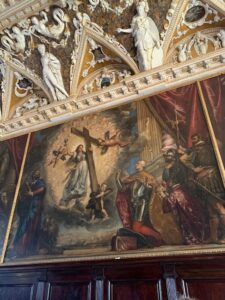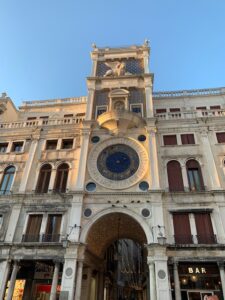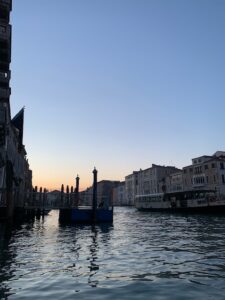Our class was able to take a weekend trip to Venice, where we had a lot of free time to explore the city. Venice is a beautiful city made up of many small islands in a lagoon off the Adriatic sea. Its unusual placement directly on the water makes it stand out from many other Italian cities and many differences and similarities can be seen between the seafaring Venice and its landlocked counterparts. Many of us rode the water “busses” (Venice’s main form of transportation) and experienced amazing works of art, like hand-blown glass on the island of Murano! Other highlights of our trip were Saint Mark’s Basilica, Palazzo de San Marco, Doge’s Palace, and both the Accademia and Guggenheim museums. Once the weekend was over, and we returned to our home base in Florence, we had a class discussion and asked our classmates several questions about our time in Venice.

Is there anything that you liked better about life in Venice than in the other cities we’ve visited? Is there anything you didn’t like? Our classmates talked about the aesthetic of the city and its picturesque views. We enjoyed the fact that there were no vehicles, which made it a quiet time away from the crazy drivers of Italy. The bridges were fun (and functional), and being on the water reminded many of us of home. Some of our classmates disliked the quiet — preferring rather the busy night-life of the city. The narrow alleys may be a great way of deterring cars, but at night the dim yellow lights and tall buildings make the city look like an endless maze of scary back alleys. Many also noted the raised prices and tourist traps at many shops, but hopefully by now most of us are good at weeding them out and staying clear of shady businesses. Since it is the off-season for tourism, many shops were closed as well, which was a bummer. And of course, Venice is a twisting and turning maze of canals, which made it quite easy to get lost.

Are there differences in how the Renaissance art looks in Venice than how it looks in Florence? To many of our classmates, the colors of the art stood out the most. The majority of the wall art we’ve seen thus far have been frescoes, however, in Venice, oil paintings steal the show. They are more vibrant, and the color lasts longer. They used oil on white canvas, adding translucent layers using a glazing technique, which was why the artists were able to produce a more realistic image. The artists could also change their minds if need be, because oil paint takes longer to dry than frescoes. The Renaissance hit Venice later than most of the country, as is shown in a less-orderly, more dramatic time period. They have developed 3-point perspective in their drawings, and the art is beautifully ornate.

What constant themes do you see in Venetian art? Many of us noted the constant symbolism of Venice’s patron saint, St. Mark, sometimes appearing as a lion with wings, a symbol then transformed to relate to all of Venice. Often accompanied by St. Mark were the archangels Micheal, who was a constant reminder of how protected Venice was, and Gabriel, who is carrying a lily to symbolize purity. It was also noted that unlike other cities, in many paintings and statues Venice was often personified as a beautiful woman adorned in lavish clothing and a powerful presence in every piece she appeared in. Another important personification was that of Justice. Justice was often shown as a woman holding a sword and scales, however, unlike in the U.S., she maintained the ability to see. Our class was informed this was because in a city with a dense population from many different places who may have some different ideas when it comes to law and order, it is very important that justice be strictly upheld to prevent the whole city from descending into disorder and chaos.

What are some common architectural elements that we’ve seen in every city so far? One unanimous answer to this question was “arches”. There have been a plethora of arches — and we have seen the progression from gothic (pointed) arches to roman (rounded) arches in every Italian city we’ve stepped foot in. The pointed arches, trefoils and quatrefoils are a huge part of gothic style architecture but as time and aesthetic changed, the roman rounded arches started to appear at the beginning of the renaissance. Specifically, the plaza outside the Doge’s palace is a good example of this progression. On one side of the plaza we saw a beautiful gothic structure, with two layers of pointed arches. The second layer was a pointed trefoil with quatrefoils placed above them. While on the other side of the plaza, built after the first, was completely different. There were still two layers, but instead of pointed arches, roman rounded arches replaced them. No trefoils, or quatrefoils were used either. This change between gothic and roman architecture is present in all the cities we have visited.
Another aspect of architecture that has been similar in each city is the façade. Our classmates brought up the competition between the cities as reasoning for the extremely beautiful façades of most the basilicas and cathedrals that we have seen. A few were never faced, due to poor budgeting or the plague, but most of the big cathedrals and basilicas we have visited have an intense façade. Every city wanted to be the biggest, most powerful city. The logic back then was, the more beautiful the façade, the more powerful the city was. The city of Venice blew our minds away with the façade on Saint Mark’s Basilica, as I am sure it would have to anyone who came across it.

What differences did you see in Venice? In most Gothic-style buildings, the main focus is height and grandeur. However in Venice, because of the island’s structural instability, they built out horizontally and not vertically. We also noted that the domes on Saint Mark’s were more onion-shaped, Eastern-influenced, rather than the classic Western-influenced domes that we’ve seen in the rest of the country. Another unfortunate difference is that the buildings in Venice are shut-down, dilapidated, and not very clean. We noticed that money is not going toward restorations, so many of the fantastic buildings will be neglected.

Why do you think Venice has a declining population? Many people recalled the dangerous aqua alta (high water) that Venice experiences more and more every year. This, some thought, may be the cause as to why people are moving away from the port city and to places more inland to keep their families and possessions safe from the dangerous levels of water. Most of our class stated that the decline had something to do with the immense amount of tourism the city faces yearly, and when talking to locals, some even mentioned that because of tourism, it was impossible to get through the main square. Having this many tourists at once would make anyone living in Venice have to go out of their way to avoid the crowds or do things that would further upset their daily routines. Many also noted that those who may like Venice but not enough to live there full-time are buying up properties in the city to use as vacation homes which causes an increase in housing rates, which could force those who could not afford the steep prices to move away. Our class thought that this vast change in the city every year may lead the local population to feel like they are strangers in their hometown and create a disconnect between them and a place that they once felt comfortable calling home. We also realized that while tourism may be destroying the citizens relationship with the city, it is also their main source of income and if it were to stop Venice could very quickly become financially unstable.

Through our experiences and observations, we were able to have a productive and helpful discussion that furthered our knowledge of the Renaissance’s impacts.

-Paige Kamin, Hannah Reckinger, Anna-Olivia Machado
Leave a Reply